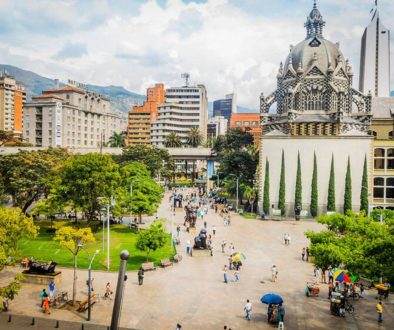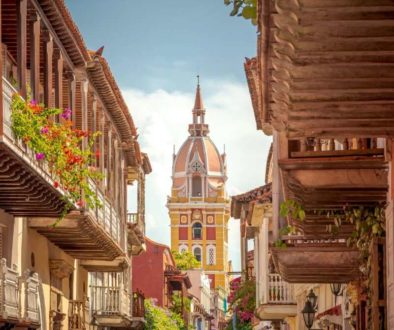Medellin, Colombia: How ‘the most dangerous city on Earth’ got a makeover
Pablo Escobar’s own neighbourhood, Santa Domingo, had been one of the worst barrios in the city. But on a scale of one to 10, the sense of threat now feels like minus eight. Like a wide balcony over the city, the piazza by the metrocable interchange was full of families – cycling children and gossiping parents. Street stalls, swathed in smoke, served empanadas and roast chicken. A busker played a tango on a battered violin, and a 12-year-old told me his dreams of playing football for Barcelona.
A new library and community centre – the Parque Biblioteca Espana – has helped the neighbourhood transform its sense of self. Just beneath the library, on steep slopes of crowded housing, the architect constructed a bamboo bridge between two warring neighbourhoods. People said it was madness; they will kill each other. The opposite happened; they got to know one another.
One of Medellin’s cable cars – the Linea L – escapes the bounds of the city altogether, rising over the top of the mountain ridge then sailing across the open spaces of Parque Arvi, Medellin’s own nature reserve, where a skein of hiking trails amble among woods and heathlands and lakes. To the south lay the green rolling hills of the Zona Cafetera with its coffee plantations and homestays and the world’s best Arabica beans.
West of the city lies its charming predecessor, Santa Fe de Antioquia, enjoying a sleepy retirement like an ageing relation. Santa Fe was the original provincial capital founded in the 16th century by Spanish conquistadors. It remains a glorious colonial town of cobbled streets and tree-shaded squares, of baroque churches and whitewashed one-storey houses whose clocks all seemed to have stopped at the moment in 1826 when the provincial government moved to Medellin.
In a square in front of the Jesuit church of Santa Barbara, where slaves were once assessed and sold, I found two elderly gentlemen bent over their atelier workbenches, creating ravishing filigree jewellery, part of a tradition in these parts that is far older the Spanish Conquest.
When they lifted their heads to say hello, the lamplight fell on long, sad faces with white moustaches and rheumy eyes. Like the quiet, cobbled square, like the houses with their gracious courtyards, they seemed to have stepped out of another world, another century.
On my last night in Medellin I pitched up at Eslabon Prendido, a pop-up salsa joint. At one end of a long narrow room, the band was weaving salsa’s complex driving rhythms; at the other, a couple of barmen were serving a stream of cold beers. The place was packed.
There seemed to be every type here, from truck drivers to hipsters, from women with heels and cleavage to willowy tattooed bohemians. Everyone was entranced the music, infected by the fever of salsa.
If I have made Medellin sound a dull goody-two-shoes, orderly as a Swiss picnic, I have done it a disservice. Let the salsa joint remind us that this is Colombia – sexy, passionate, tempestuous, and with astonishingly beautiful people.
The horn section wailed, and a packed floor of dancers, intense and sweaty, surfed through the music. The place crackled with erotic electricity.
This too was Medellin. The metro might be squeaky clean but the salsa, happily, was as dirty as ever.
More information colombia.travel
Staying there Most people base themselves in the leafy Parque Lleras area of El Poblado, an upscale residential district south of the centre with a number of good hotels, restaurants and bars. The funky Charlee (thecharlee.com) has doubles from around $250.
Patio del Mundo (patiodelmundo.com) is a charming new boutique property – stylish, light and friendly.
Eating there Visit Mondongos (mondongos.com.co) at No. 38 Calle 10 for its bandeja paisa: a regional dish of beans, fried pork, maize buns, plantain and black pudding.
Alambique is a fabulous rooftop bar and restaurant at No. 106 Carrera 41 – vegetation, salvaged materials, serious trendsetters, stunning food and a cocktail list to confuse and delight.
Doing there For the hottest dance moves, check out eleslabon For the hottest dance moves, check out eleslabon.
By Stanley Stewart
The writer travelled with Steppes Travel (steppestravel.com).



